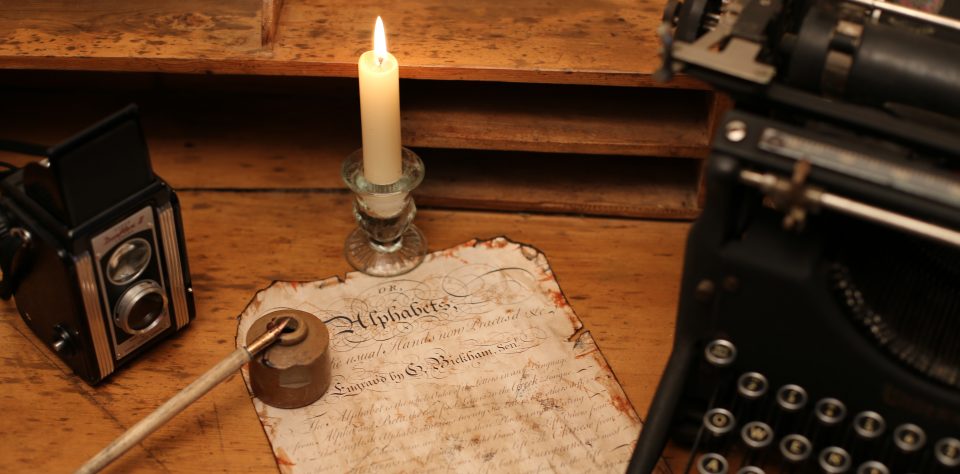Tags
bekindrewrite, creative writing, flash fiction, good short stories, Inspiration Monday, K Patrick Moody, Kim P Moody, old straight path, rusty blade, writing ideas, writing prompts
Last month the assignment was to create a list of titles, for inspiration, the way Ray Bradbury did – look back and see my list. This month, part one of the assignment is to write about 300 words inspired by one of the titles. I had a long list, so I’ve used two of the titles. Read on …
1 – The Rusty Blade
There were only a few houses in the village, back then. Each one stood alone on its own plot, built with the local deep red bricks, two floors, and black slate on the roof. The curtain-less windows, framed with flaking cream paint, stared dark across the long, weedy garden, watching over a black stained, wooden shed.
We were a pair of lads, eight years old, with nothing much to do but be guided by our curiosity and imagination. We hadn’t taken much notice before, but this time the gaping door to the tumble-down workshop seemed to call. Nobody had been to the house since last year. The only sign of visitors was the track through the long grass made by the local cat – or maybe rats.
It took a few minutes for our eyes to get accustomed to the gloom, and as the darkness retreated, a solid wooden bench loomed to our left. The air was stale, damp and musty; the only sound was the autumn breeze scraping the brambles against the wall. A whole mess of rusty hand tools were spread around, most I could name; grandad’s shed had a load just like them. We pulled open the drawers, heavy with nails, screws, more smaller tools, all covered in the dust of time.
 In the far corner, covered with old potato sacks, was a shape. It hunched about waist high. Resting on the top of the sacks was a tool I had not seen before. Forged from iron bar, it had a loop handle – big enough for a man’s hand. The shaft ended in a long spike, like a shark’s tooth, curving slightly back towards the handle. I know now it was a logging hook, but then, this fearsome weapon, with its evil point, blood red with rust, set the hairs on my neck a-tingle.
In the far corner, covered with old potato sacks, was a shape. It hunched about waist high. Resting on the top of the sacks was a tool I had not seen before. Forged from iron bar, it had a loop handle – big enough for a man’s hand. The shaft ended in a long spike, like a shark’s tooth, curving slightly back towards the handle. I know now it was a logging hook, but then, this fearsome weapon, with its evil point, blood red with rust, set the hairs on my neck a-tingle.
I reached for the handle. My foot caught on the sacking. The shape lurched at me, and sent me sprawling backwards – the spike clattered between my feet. The log pile rattled across the floor. Then silence.
2 – The Old Straight Path
 The path ran down from the edge of the village straight to the white bridge, and over the river where we used to swim in the summer. Farther on it reached the next village across the water meadows.
The path ran down from the edge of the village straight to the white bridge, and over the river where we used to swim in the summer. Farther on it reached the next village across the water meadows.
The path was old, very old, dipping down below the level of the fields either side, and the trees meeting over the top, formed a tunnel.
Most times we walked the path in a group, laughing and playing, with our bathing trunks rolled in a towel. But later in the year, when it wasn’t warm enough to swim, and I was alone, the path had a darker feel; long shadows, chill breezes rushed between the branches, chasing the fallen leaves.
As I looked into the slow running water below the bridge, shapes would drift past behind my reflection – but when I spun round only the branches stirred overhead.
Now that I have found out about ley lines, funeral, straight, and coffin paths, I understand why such a path endured centuries of foot traffic. It lead directly from a village with no church, to ours, where their local dead could be could be carried along a ceremonial route, to be buried in the consecrated ground. This route crossed the river, and ensured that when the funeral party returned to their village, the spirit of the deceased could not follow.
The path is gone now, buried beneath a sprawling industrial estate. The white bridge is still there, and the river swirls under it … and the path on to the distant village can be made out crossing the meadow.
I wonder, how many lonely and confused souls still wait at the bank, unable to return?
© 2017. K Patrick Moody

Love them both. What a relief after the buildup of tension in the first story! And the second one feels so rich with history and memory. Both felt very real.
The first was a lesson to kids not to go snooping where they shouldn’t – although it never stopped us! In the second the path was real, but the ‘coffin path’ association was as a result of a book about ley lines and the like that I read recently.
Pingback: Bradbury InMon: The Stories – bekindrewrite